 Access Key Details
Access Key Details
Early Radio and Television
This page contains selected articles from old UK radio magazines dealing with the early days of radio and television.
This page contains articles dealing especially with receivers,
and some miscellaneous illustrations.
I have no idea if these ancient articles are copyright or who would own it- if anyone wishes to claim content and ask for it to be acknowledged or removed, do please contact me. I can find no indication that anyone else has this material and physically it won't last much longer.
Go to Early Radio Contents Page
Click on the image below for a larger image, use back button to return here.
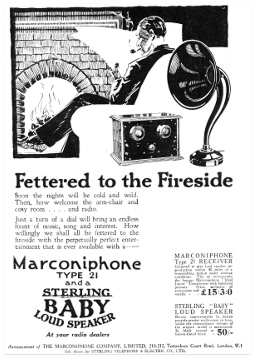 Fettered to the fireside.
Fettered to the fireside.
Soon the nights will be cold and wild. Then, how welcome the arm-chair and cosy room . . . and radio.
Just a turn of the dial will bring an endless fount of music, song and interest. How willingly we shall all be fettered to the fireside with the perpetually perfect entertainment that is ever available with a:
Marconiphone Type 21 Receiver.
Designed to give loud speaker reproduction within 40 miles of a transmitting station under average conditions. This set incorporates the famous Marconiphone "Ideal Junior" transformer with bakelised primary. Price inclusive of accessories and royalty. GBP 15:3:0 (GBP 15.15)
Chakophone Portable 5 Valve Receiver.
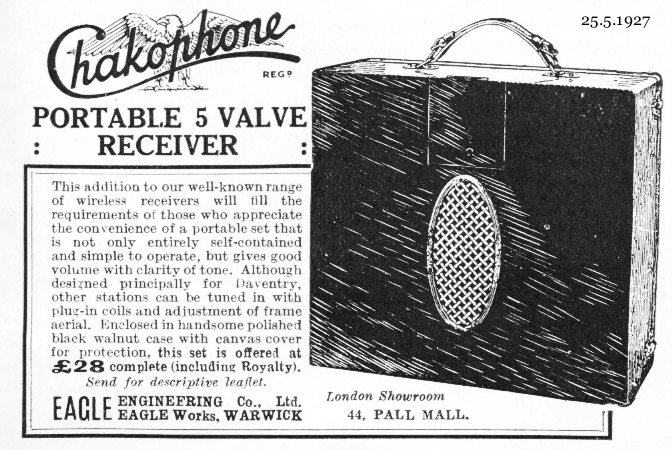
This addition to our well known range of wireless receivers will fill the requirements of those who appreciate the convenience of a portable set that is not only entirely self contained and simple to operate but gives good volume with clairty of tone.
Although designed principly for Daventry other stations can be tuned in with plug in coils and adjustment of frame aerial.
Enclosed in handsome polished black walnut case with canvas cover for protection.
Eagle Engineering Co Ltd., Eagle Works, WARWICK.
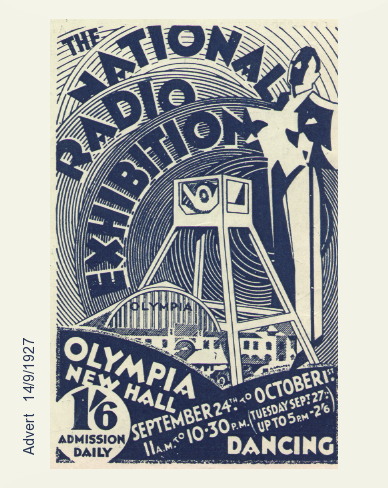
Advert for National Radio Exhibition at London Olympia 24 Sept to Oct 1st 1927, admission 1s 6d (7.5p)

R.I. Ritz Airflo
A Sensitive Superheterodyne with Many Points of Originality
FEATURES:
Type.-Table model superheterodyne for AC mains incorporating QAVC.
Circuit.-
Triode-pentode frequency changer
variable-mu pentode IF amplifier
triple-diode-triode second detector
pentode output valve
Full wave valve rectifier.
Controls.-
(1) Tuning.
(2) Volume and on-off switch.
(3) QAVC threshold control.
(4) Waverange switch.
(5) Tone control
Ten inch moving coil loudspeaker.
Price : 16 guineas. [ GBP 16.80. Inflation makes one pound in 1935 equal in cost to fifty pounds in 2014]
Makers:-Radio Instrumcnts Ltd., Purley Way, Croydon.
A new superhet by COSSOR
All-Electric model 364
with THERMOMETER tuning.
11 gns
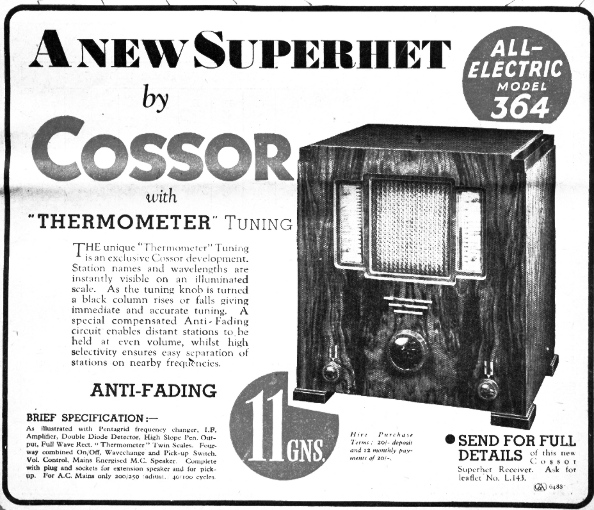
THE unique "Thermometer" Tuning is an exclusive Cossor development. Station names and wavelengths are instantly visible on an illuminated scale. As the tuning knob is turned a black column rises or falls giving immediate and accurate tuning. A special compensated Anti-Fading circuit enables distant stations to be held at even volume, whilst high selectivity ensures easy separation of stations on nearby frequencies
ANTI-FADING
BRIEF SPECIFICATION As illustrated with Pentagrid frequency changer, I.F. Amplifier, Double Diode Detector, High Slope Pen. Output, Full Wave Rect.
"Thermometer" Twin Scales. Four- way combined On/Off, Wavechange and Pick-up Switch. Vol. Control, Mains Energised M.C. Speaker. Complete with plug and sockets for extension speaker and for pick- up. For A.C. Mains only 200/250 40/100 cycles.
Hire Purchase Terms : 20/- deposit and 12 monthly payments of 20/-
SEND FOR FULL DETAILS of this new Cossor Superhet Receiver. Ask for leaflet No. L143
(Historic note- The company Cossor went to Raytheon but the trade name Cossor Radio went to Philips / Visionhire)
[11 gns was GBP 11.55 and 20/- was GBP 1.00 - The RPI cost of living index in 2012 was 50 times more than it was in 1935!!]
15th March 1935 - Adverts
These advertisements appeared on Friday 15th March 1935. Click on the thumbnail to see the larger image. To return to this page use your browsers back button.



Text of adverts:
Eclipse Saws
Unbreakable in Use
Eclipse blades are made in 4 types: all hard; flexible; double edge; and high speed steel.
Specify ECLIPSE Hack Saw Blades and Frames
Obtainable from all tool dealers
Sole Manufacturers:
James Neill & Co. (Sheffield) Ltd., Sheffield, 11
British Insulated Cables
B.I. Copper Earthing Rods for wireless apparatus (Patent applied for)
50% More Surface Area
Here is a line which will interest every one of your customers, an Earthing Rod designed to give low resistance. Made from solid drawn H. C. copper. The multiple fins ensure larger surface area and better contact with the earth than any driving earth of similar diameter and weight on the market; and nearly 50% more contact area than a similar rod of equal diameter. The heavy centre core is strong and not easily turned aside by obstructions. Complete with clamp ring and binding screw. In two sizes, 18in and 24in. Write for terms.
British Insulated Cables Ltd.,
Cable makers and electrical engineers
Prescot, Lancs. Tel No PRESCOT 6571
R G D Radio Gramophone
An RGD Radio Gramophone
will give years of enjoyment.
Its period of maximum efficiency is not measured in months but years.
Performance is superior to that generally available . . performance that completely satisifes.
"An instrument of outstanding technical quality" (Wireless World Test Report)
"The aristocrat of the radio world"(Daily Mail)
A fully illustrated descriptive brochure contains complete specifications of R G D Radiogramophones. It will be sent free on request. R G D Models are priced from 50 to 130 guineas [1 guinea= GBP 1.05] 7 to 13 valve superheterodyne radio gramophones including the superb Model 1203 All-wave instrument.
Radio Gramophone Development Co Ltd, 17-20 Frederick St, Birmingham 1.
Licensed under Br Pats 325835 abd 333142.
[The RPI cost of living index in 2012 was 50 times more than it was in 1935!!]
For each advert, you can click on the smaller image shown for a larger image, use your browser back or return button to get back here.
Colvern Ltd
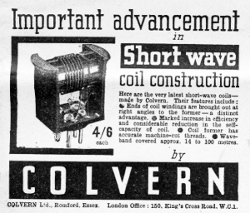
Important advancement in Short wave coil construction.
Here are the very latest short-wave coils - made by Colvern. Their features include: Ends of coil windings are brought out at right angles to the former - a distinct advantage; Marked increase in efficiency and considerable reduction in the self-capacity of coil; Coil former has accurate machine-cut threads; Waveband covered approx. 14 to 100 metres.
By COLVERN
Colvern Ltd, Romford, Essex. London office: 150, King's Cross Road, W.C.1.
Claude Lyons Ltd resistors
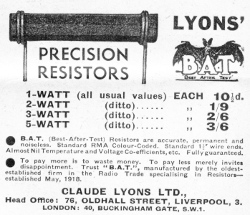
Lyons' BAT. Precision Resistors.
1-watt (all usual values) each 10 1/2d
2-watt (all usual values) each 1/9
3-watt (all usual values) each 2/6
5-watt (all usual values) each 3/6
B.A.T. (Best After Test) resistors are accurate, permanent and noiseless. Standard R.M.A. colour-coded. Standard 1 1/2 inch wire ends. Almost nil temperature and voltage co-efficients, etc. Fully guaranteed.
To pay more is to waste money. To pay less merely invites disappointment. Trust B.A.T., manufactured by the oldest established firm in the Radio Trade specialising in Resistors - established May 1918.
Claude Lyons Ltd, Head Office: 76 Oldhall Street, Liverpool 3.
London: 40 Buckingham Gate, S.W.1.
[ 10 1/2d = approx 4 1/2p; 1/9=9p; 2/6=12 1/2p; 3/6=17 1/2p ]
[The RPI cost of living index in 2012 was 50 times more than it was in 1935!!]
Ferranti Valves
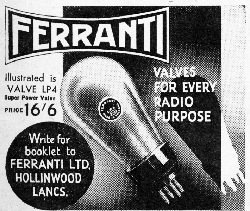
FERRANTI.
Valves for every radio purpose
Illustrated is Valve LP4 super power valve, price 16/6.
Write for booklet to
Ferranti Ltd, Hollingwood, Lancs.
[16/6 = 82 1/2p. The RPI cost of living index in 2012 was 50 times more than it was in 1935!!]
Telephone Manufacturing Co Ltd Capacitors
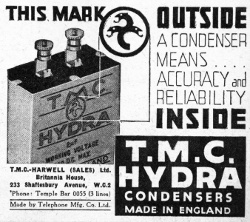
This mark [mark] outside a condenser means accuracy and reliability inside.
T.M.C. HYDRA CONDENSERS. MADE IN ENGLAND.
T.M.C.-Harwell (Sales) Ltd
Britannia House, 233 Shaftesbury Avenue, W.C.2.
'phone: Temple Bar 0055 (3 lines)
Made by Telephone Mfg. Co. Ltd.
[Note: A condenser is now referred to as a capacitor]
Dubilier Volume Controls
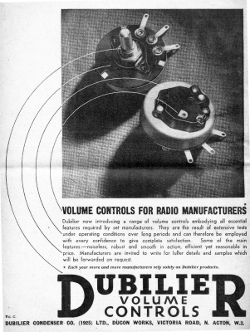
VOLUME CONTROLS FOR RADIO MANUFACTURERS
Dubilier now introducing a range of volume controls embodying all essential features required by set manufacturers. They are the result of extensive tests under operating conditions over long periods and can therefore be employed with every confidence to give complete satisfaction. Some of the main features: noiseless, robust, and smooth in action, efficient yet reasonable in price. Manufacturers are invited to write for fuller details and samples which will be forwarded on request.
Each year more and more manufacturers rely solely on Dubilier products.
Dubilier Volume Controls.
Dubilier Condenser Co (1925) Ltd, Ducon Works, Victoria Road, N Acton, W.3.
[Volume controls were variable resistors; for volume control purposes there was a need for operation that did not generate crackles. Decades later frequent use of cheap brittle carbon volume controls led to many devices being thrown out just because the volume control was too noisy or unreliable due to the break up of the carbon.]
H.M.V. Model 340
A Universal Superheterodyne with an Interesting Reflex Circuit
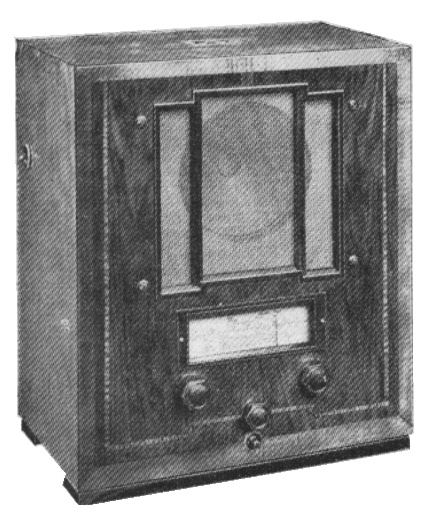 FEATURES
FEATURES
Type.--Table model superheterodyne for AC or DC mains.
Circuit.--Heptode frequency changer-combined IF amplifier, second detector and LF amplifier - pentode output valve. Half-wave valve rectifier.
Controls.(1) Tuning. (2) Volume; (3) Waverange. (4) Mains on-off switch.
Price. - 11 1/2 guineas (GBP 12.08).
Makers. - The Gramophone Co., Ltd., 98/108, Clerkenwell Road, London, E.C.1
THIS receiver works equally well on DC or AC mains, and has been designed for supply voltages between 195 and 255 volts, and, in the case of AC mains, for frequencies from 25 to 60 cycles.
It should appeal particularly to those who may be moving into another district in the near future, or in cases where there is a possibility that the supply may be changed from DC to AC. From the point of view of design and workmanship the set bears the unmistakable stamp of H.M.V. quality, and it is housed in a compact cabinet finished in various tones of polished walnut veneer.
The price is very reasonable, and an ingenious reflex circuit is largely responsible for the reduction of manufacturing costs.
The field of the energised moving coil loud speaker is connected across the HT supply and a hum-bucking coil is included to neutralise mains hum.
A muting switch connected across the primary of the output transformer is associated with the waverange switch to obviate switching noises when changing from medium to long waves.

Lotus Model 66
A Universal Receiver with a Three Valve Straight Circuit.
Features:
Table model straight receiver for AC or DC mains
Circuit: Var-mu pentode HF Amplifier, pentode grid detector with reaction, pentode output valve, half wave valve rectifier. (Note for American readers: Valve= Tube).
Controls: Tuning, Volume with on-off switch, Reaction, Waverange and gramophone switch.
Price: 8 gns (GBP 8.40)
Makers: Lotus Radio (1933) Ltd, 195 Judd Street, London WC1.
In view of the popularity, both with manufacturers and the listening public, of the superheterodyne principle, it is interesting to find one of the new universal receivers employing a simple three valve straight circuit.
Although the superheterodyne may be expected to give a higher degree of selectivity, it is equally true that the straight circuit with a single HF stage is capable of giving sufficient selectivity for the needs of the very large section of the listening public who are interested primarily in the reception of the local programmes with a few foreign stations as a matter of interest.
Sets of this type also have the advantage of being free from second channel interference trouble and of course the reduced cost of manufacture enables the set to be sold at an attractive price.
It is unusual to find provision for a gramophone pickup in universal receivers, but this feature is incorporated in the model 66.
[ sjs notes. There is a transformer in this set, the HF stage output passes through one to the detector, with a coupled reaction coil, with a variable capacitor to control "reaction". There is no mains voltage transformer however and the unit mains switch and fuse are on the "negative mains lead".
Modern loudspeakers use a powerful permanent magnet, but the model 66 has a DC high voltage powered electro magnet for the speaker field. The four valve heaters and two pilot lamps are in series with full DC high voltage across them, protected by a "barretter", a special resistor sensitive to heat which took the initial switch on high voltage before the heaters and lamps had warmed up.]
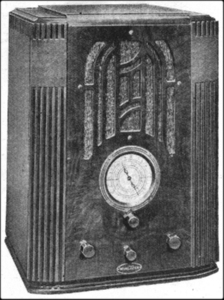
Wurlitzer-Lyric Model 471B
An All-wave Superheterodyne of High Sensitivity and Good Tonal Quality.
FEATURES.--Type.-Table model AC superheterodyne for long, medium and short wavelengths.
Circuit.---Var.-mu pentode HF amplifier--heptode frequency-changer--var.-mu pentode IF
amplifier--double-diode-triode second detector-separate AVC rectifier-power pentode output valve.
Full-wave valve rectifier.
Controls.(l) Tuning, calibrated in kc/s. (2) Volume and on-off
switch, (3) Waverange switch. (4) Tone control. Price.---20 guineas.
Makers.--Wurlitzer-
Lyric Radio Ltd Leicester Square Chambers, Leicester Square, London. W.C.2.
June 1935
[20 guineas was GBP 21.00. The RPI cost of living index in 2012 was 50 times more than it was in 1935!!]

Ferranti's New Radio Works
Production of Complete Sets, Including Valves
Under One Roof
The transfer of the radio section of Ferranti,
Ltd., from the main Hollinwood works to
the new factory at Moston is now complete.
The removal of each department, a section at
a time, without interrupting supplies, has been
a triumph of organising ability, of which
there is still further evidence in the layout and smooth working of the new factory now that it
has settled down to production.
The parallel component benches feeding parts to the main
assembly line just at the point where they are required is no
doubt a familiar feature of wireless receiver production,
but there are few
manufacturers who can claim to have under unified control
in the same building the supply not only of
wood and moulded cabinets, but also loud speakers, condensers, and even valves of their
own design and manufacture.
The whole factory of 270,000 sq. ft. is on one floor only. It is exceptionally well lighted
and there is no overhead shafting, every machine being independently electrically
driven.
On the occasion of a recent visit we were
duly impressed by the 750-ton press for turning out the new dual colour cabinets and other
spectacular processes, but more so by the unobtrusive efficiency of the organisation.
Another point which seemed worthy of note was
that research and development departments were distributed throughout the works in close
proximity to the actual work of production with which they were concerned. There was
also a school through which all new recruits to the factory have to pass before being allowed
to take up their responsibilities in the works.
There can be little doubt that the new season's Ferranti sets will be well and truly made.

What is it like on SHORT WAVES?
TODAY, the first question you are likely to ask about a new receiver is : "What is it like on short waves ?" For most people realise that they are now increasingly dependent on the short wave bands for variety and quality of news and entertainment.
"His Master s Voice" Model 1107 embodies fundamental technical improvements which give from aerial to mixer anode up to a four-fold gain in sensitivity and signal-to-noise ratio as compared with previous equivalent types of receiver.
In terms of performance this means greatly increased entertainment value from a wider range of stations, especialy on short waves.
Push-button wavechange; more effective A.V.C.; improved tone control; generous output ; unimpeachable quality ; pre-war standards of construction; moderate price -all these make up a specification which meets your radio needs at every point.
FEATURES:
High Gain Aerial Circuit
New Type Steep Slope Mixer
All-wave reception: 16.5-52 metres, 192-570 metres, 720-2,000 metres.
Specially designed Tone Control
Pick-up and external speaker sockets
5 watts rated output
Suitable for A.C Mains, 195-255 volts, 50-100 cycles
MODEL 1107 5 valve all-wave superhet for A.C. Mains 11 GNS (GBP 11.55)
"His Master's Voice"
THE GRAMOPHONE COMPANY LIMITED - HAYES - MIDDLESEX
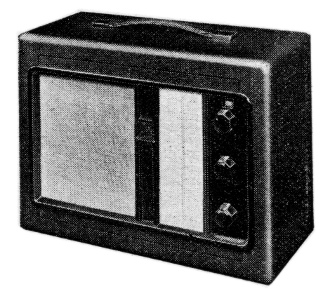
H.M.V. "All-dry" Portable
THE new Model 1403 with which the Gramophone Co., Ltd., have entered the "all-dry" portable market is a 4-valve superheterodyne housed in a neat, leather cloth covered case measuring (converted to metric 2015:) 276mm by 358mm. The weight, complete with batteries, is 9.9 Kg and the price GBP 8 10s. 6d (GBP 8.52)
The frame aerial is wound on the back panel of the set in helix form and covers the medium-wave band from
200 to 565 metres. For longwave reception the range is extended by an iron-cored loading coil and the
wave-lengths covered are 850-2,000 metres.
A combined 99 volt HT and 1.5 volt LT battery supplies the valves, and has a life of approximately 250 working hours. A plug and socket change-over device enables separate HT and 1.5 volt bell-type LT batteries to be used if desired.
A special lightweight loud speaker and a full size station-calibrated dial are features of the H.M.V. Model 1403 "all-dry" battery portable.
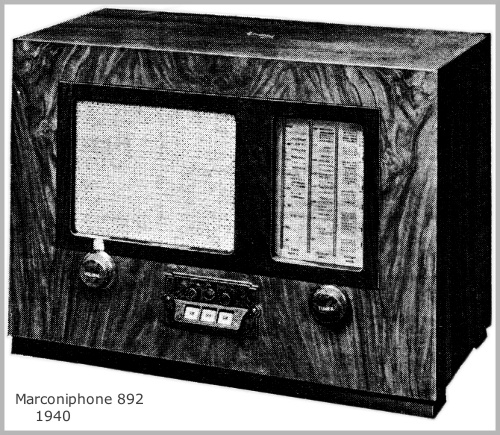
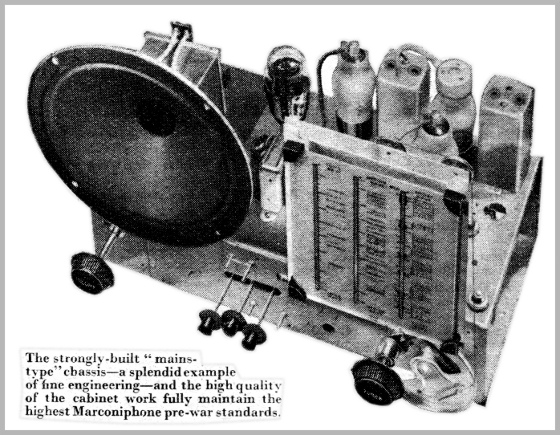
June 1940 Advertisement
Marconiphone Model 892
Big Set performance for 5mA
Thanks to the 5 great economy features of the new Marconiphone 892.
1. The Battery Economiser. With the switch in the "Normal" position, H.T. consumption is halved; yet volume and sensitivity are ample for ordinary listening requirements. Only when maximum sensitivity and even greater output are required need the Battery Economiser be switched out of circuit. H.T. consumption then goes hack to 10 mA.
2. High Gain aerial circuit. As good as an extra valve but without the extra battery consumption.
3. Super-sensitive speaker. Works wonders from a very small output wattage- more volume, greater purity. Magnet efficiency of 10,000 gauss.
4. Duplex action A.V.C. Almost perfect control of volume. More stable output prolongs battery life still further.
5. Low price. In spite of all these technical improvements, exceptional manufacturing facilities have enabled the price to be kept down to 11 gns. including batteries.
The strongly-built "mains- type" chassis- a splendid example of fine engineering- and the high quality of the cabinet work fully maintain the highest Marconiphone pre-war standards.
MARCONIPHONE 892, 4 valve 7 stage, all-wave battery superhet.
11gns (GBP 11.55)
The Real Thing in Radio.
MARCONIPHONE
THE MARCONIPHONE COMPANY LIMITED
HAYES MIDDLESEX
All of this text was on one single page advert. Not mentioned in the advert, I believe the radio was Model A92 (main) and B91 (battery). The end of the advert has a simple line "C R Casson 963" - I understand that C R Casson was an advertising agency employed by Murphy. On to the advertisement.
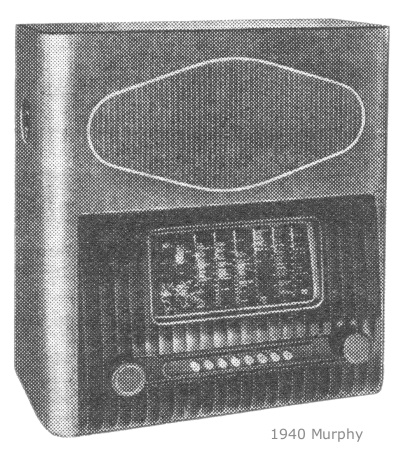 June 1940:
June 1940:
Presenting the new short-wave MURPHY "STATION - MASTER"
The Murphy Short-Wave "Station-Master" mains and battery models feature short-wave station names which at last have a true meaning, and lead to unusual simplicity of short-wave tuning. The accuracy and stability of the calibration are such that it is possible to tune and re-tune any given short-wave station with certainty.
The Short-Wave "Station-Master" embodies marked advances in all the requirements which the Murphy tradition of short-wave 'specials' has established in the last few years: (1) Ease of tuning ; (2) Adequate image suppression; (3) Adequate gain- more sensitivity being required. on short waves than on the ordinary wavebands; and (4) Frequency stability to permit accurate tuning and re-tuning of a given short-wave station.
STATION NAMES ON SHORT WAVES
The most striking feature of the "Station-Master" is the scale, on which no distinction is made between the six short-wave bands covered and the two normal broadcast bands. A separate scale with station names (95 in all) has been provided for each band, the required range being selected by one of the eight wave range push-buttons. A separate set of coils is brought into operation for each band, and band-spreading is achieved by small condensers in series with the main tuning condenser.
The effect is to make tuning on the short-wave bands as "broad" and as easy as it is on medium and long waves. Hitherto, tuning short-wave stations, even on sets with some form of band- spreading, has been more diflicult than tuning medium-wave stations, largely because it has not been possible to provide the ten-fold increase in calibration accuracy needed to make the scale markings equally reliable. Under such conditions, calibrating short-wave scales with station names was not only useless, but also misleading.
As an alternative, logging dials of various sorts have been provided and have proved quite useful to people who were prepared to take a little trouble -but they still fell short of our ideal of real simplicity and certainty in tuning short-wave stations.
The "Station-Master" represents an approach to this ideal in producing commercial "band spread" receivers- an approach made possible by our previous experience, coupled with the evolution of more stable circuits, in the following ways. In the oscillator circuit 'warming up' drift due to changes in valve capacities- has been reduced by using larger fixed tank capacities across the coils. One of these has a negative temperature coefficient, so that drift due to changes of temperature, whether due to the heating up of the set itself, or changes in room temperature, are compensated. Drift due to changes of atmospheric humidity has been reduced by suitable impregnation of the oscillator coils. The fixed tuning capacities are of the silver-on-mica type, and are wax impregnated.
WAVEBANDS COVERED
The usual 21-metre amateur band has been replaced by the 13-metre broadcast band, and the 42-metre broadcast band has been incorporated with the 49-metre band. The tuning arrangements are such that this can be done while maintaining adequate band-spreading, but only a very rough station name calibration is possible on 42 metres. This band is not considered important enough to justify the added complication and cost of a button and scale to itself.
On laboratory tests the accuracy and stability of the short-wave scales are surprisingly good, but with such a radically new development caution is necessary, and it would be unwise to expect the short-wave station names to be as completely reliable indications as the normal medium-wave station names, especially since the stations them- selves cannot all be relied on to keep their allotted wavelengths.
But if the short-wave names are regarded as 'sign- posts' they will be found extremely useful, and the improvement in ease of operation is remarkable.
OTHER TECHNICAL ADVANCES
A new image suppression circuit has been developed for short waves, and is extremely simple and effective.
The type of pre-selector used has been designed so that the long-wave aerial coils provide higher gain at the lower wavelength end of the band, and at the same time act as an improved low-pass filter to minimise break-through of medium-wave stations. Automatic volume control on the "Station-Master" is undelayed. This tends to minimise the annoyance of selective fading on short waves, and also results in a slight increase of selectivity. Gain is increased by the use of an HL41DD valve in place of the usual variable-mu type. A heterodyne whistle-filter is connected in the anode circuit of the output valve.
A high-slope R.F. amplifying stage, using a Mazda television type SP41 valve, is employed on short waves only and is followed by the new and very simple image suppression device mentioned earlier. A Colpitts oscillator circuit is used, and is band-spread, in common with the inter-valve circuit, by small condensers in series with the main tuning condenser. As the aerial circuit is in any case damped by the aerial itself, it is pre-set to the middle of the various bands.
A 1imit is set by the prevailing noise-level to the amount of sensitivity which can be usefully employed in a receiver. Too much gain in the R.F. stage is a frequent cause of interference, due to stations 465 Kc/s apart interacting with each other and with the wanted station at the frequency-changer.
There is thus a more or less definite optimum value, and advantage is taken of the fact that we use switched inductances in the "Station-Master" suitably "to doctor" the R.F. stage on each wave-band to maintain its gain as close as possible on all wavebands to this optimum value.
REPRODUCTION
Emphasis has been placed in the "Station-Master" on range and performance. Variable selectivity has been omitted in the interests of other features felt to be more important at the present time, but apart from this limitation, quality will be found to be of an unusually high standard. The Pen45 output tetrode delivers ample power to the 8-inch moving coil speaker, which has a remarkably well-balanced response.
Special attention has been given to the response on short waves. For short-wave reception, emphasis must be placed on speech rather than music, and a response which is optimum for music is liable to have too much bass for optimum intelligibility on speech. This effect is accentuated when the tone control is turned down, as is so frequently necessary on short waves to remove noise and interference. For this reason, the bass response has been slightly restricted on the short-wave ranges, and the intelligibility of 'difficult' short wave stations has been thereby improved.
THE BATTERY SHORT-WAVE "STATION-MASTER."
The battery-operated edition of the "Station-Master" incorporates most of the outstanding short-wave performance features of the mains model, including accurate short-wave station names on the scale and the advantages of band-spreading, making short-wave tuning as easy as on medium waves. It is, in fact, the first commercial battery receiver to offer anything like this high standard of short-wave performance.
A single pre-selector is used and a wavetrap is provided where necessary. On medium and long waves, the circuit comprises a triode-pentode frequency changer, followed by an I.F. stage; a diode triode for detection; A.V.C. and L.F. amplification; and a Q.P.P. (Quiescent Push-Pull) output stage. Grid bias is automatic.
As on the mains set, an R.F. stage is brought into circuit on short waves. It has a tuned anode coupling to the frequency-changer, because the limitations of battery valves make it necessary to forgo the relinement of the new image suppression circuit, except on 49 metres. A very stable Colpitt's oscillator circuit is also used, and the oscillator and tuned anode couplings are band- spread, the aerial being pre-tuned on each band.
The addition of the R.F. stage in conjunction with the system of using a separate group of pre-set coils for each waveband results in adequate gain, a good signal-to-noise ratio, and good image suppression. Although in these respects the performance is not, of course, quite as good as the mains "Station-Master" with its high slope R.F valve and special image rejector, it will be found to give a very high standard of short-wave performance, throughout the life of the H.T. battery.
Cash Prices
A.C. MAINS SHORT-WAVE "STATION-MASTER" GBP 15.15 (GBP 15.75)
BATTERY SHORT-WAVE "STATION-MASTER" (without batteries) GBP 14.10 (GBP 14.50)
All Murphy Sets, exclusive of valves and batteries, guaranteed for a year. Prices do not apply in Eire.
Hire Purchase Terms on all models.
C. R. Casson 963
That was the advert, now for the editorial in the same June 1940 magazine:
THE principle of electrical band-spread tuning which has always found a place in Murphy short-wave "specials" is again applied in the recently introduced A92 receiver, but with the important addition of station calibration down to the shortest wave-lengths.
Each important short-wave broadcast band-13, 16, 19, 25, 31 and 41-49 metres is selected by a push-button switch and has been given a separate scale; altogether there are 95 station names. Accuracy of calibration has been assured by close attention to frequency stability in the oscillator and IF (intermediate frequency) circuits.
As in the A76, a high-gain RF (radio frequency) stage is used on short waves to give a high signal-to-noise ratio, and the image suppression and selectivity generally are claimed to be superior to those of the earlier design- no mean performer in these respects. The Pen45 output valve delivers 4.5 watts to an 8in. loud speaker and quality should be good, though there is some restriction of frequency range, as variable selectivity is not included as it was in the A76.
The new B91 is the battery equivalent of the A92 and it has the same features of high sensitivity, signal-to-noise ratio and image suppression, as well as the station-calibrated band-spread dial. There is an RF (radio frequency) stage on short waves only and the output is from a QPP (Quiescent Push-Pull) stage. The average HT (high tension, higher voltage) consumption on medium and long waves is 10 mA from a 120-Volt battery-slightly more on short waves. Grid bias is automatic.
The price of the AC model A92 is GBP 15.75 and of the battery B91 GBP14.50, without batteries.
Radiogramophone versions ot the "90" series have also been introduced. They are the A90RG at GBP 26, and the D90RG at GBP27.50. A 10in. loud speaker is fitted and the pick-up is of improved design, with low record wear. As in previous Murphy radio-gramophones, the motor board is flush with the top of the cabinet.
[note- the use of QPP audio in 1940 was a bit late in the day as Class B2 was taking over.]
Later in 1940: another lengthy advert for this radio- using the same image- this is from November 1940:
A Rose by any other name
In a "Wireless World" advertisement a year ago we were talking about the war-time future of the Radio Industry. "Service of the country's vital war needs," we said," may leave us short of some materials, but if or when the time comes, we'll find alternatives."
A great deal has happened since then-much more than any of us expected, or perhaps would have believed possible. But to-day we know a lot more surely where we stand in all sorts of ways. We know, for instance, that most of the aluminium we can get must go into the specialist gear we are turning out in ever-growing quantity and variety for the armed Services. And for use in domestic radio sets- which still have their own great work to do in the homes and factories of the people, and in the camps and barracks and depots of the soldiers, sailors and airmen -some reliable alternative must be found.
That's just one of the problems the war has brought us, and like many more its solution has entailed some very interesting design developments. In future advertisements we hope to describe a few of these- and to show that with them all Murphy sets remain substantially as they were.
There cannot be so many of them these days- and there certainly aren't enough to go round, so that some people have to be kept waiting a bit- but we can and do insist that those we do turn out must keep up the Murphy reputation for sound design, high performance, and lasting reliability.
Some of you DX enthusiasts who cannot find time to build your own sets, and who cannot lay hands on pukka communications sets these days, should try one of the Murphy Station Masters. These models have electrical band-spreading for the principal short- wave ranges between 21.6 and 6.0 megacycles, real station name calibration for nearly 100 short-wave transmitters, and a high slope television-type R.F. stage for short-wave only . . . and though the Purchase Tax will put up the prices a bit, both sets are still well worth the money they cost.
Cash Prices
A.C. MAINS SHORT-WAVE "STATION-MASTER" GBP15 15s
BATTERY SHORT-WAVE " STATION-MASTER " (without batteries) GBP14 10s
ALL MURPHY SETS, EXCLUSIVE OF VALVES AND BATTERIES, GUARANTEED FOR A YEAR
PRICES DO NOT APPLY IN EIRE.
MURPHY SETS ARE STILL AVAILABLE FROM MURPHY DEALERS
MURPHY RADIO
MURPHY RADIO LIMITED, WELWYN GARDEN CITY, HERTFORDSHIRE
C.R.C.965
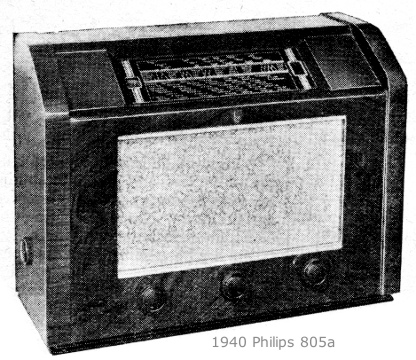
Shortwave 16.7 to 51 metres; Mediumwave 197 to 580 metres; Longwave 708 to 2000 metres.
Test Report
Philips Model 805A
AC SUPERHETERODYNE (FOUR VALVES + RECTIFIER) WITH "SILENTRON" RF STAGE
PRICE: 13 GUINEAS
BUILT to provide an outstanding short-wave performance at a reasonable cost, this new Philips receiver dispenses with "frills" such as push-button tuning which do not contribute to that end. An efficient cathode-ray tuning indicator is fitted, however, since this provides a valuable indication of comparative signal strength and the degree of fading which may be present. Medium- and long-wave ranges are, of course, included, and there is provision for a gramophone pick-up.
Circuit.- The so-called "Si1entron" pentode valve with aligned grids is employed in the RF stage to give the highest possible signal-to-noise ratio. It is preceded by a single tuned circuit in the aerial and is coupled by transformers, tuned on all three wavebands, to the triode-hexode frequency changer. The high intermediate frequency of 470 kc /s has been chosen to reduce second channel interference as far as possible. When the circuit is switched for gramophone reproduction the pentode valve in the IF stage is converted
to a triode, using the screen grid as anode, and is then connected as a first-stage AF amplifier before the pentode output valve.
The pentode section of the final stage is rated for a maximum anode dissipation of 9 watts, and no permit is required to purchase the set. The undistorted output available is 4 watts.
Performance.- There is ample volume from the permanent-magnet loud speaker, and an internal cone diffuser gives good distribution of high-note response. The middle register is well filled out, and if there is a suggestion of rather less bass than usual this must be accounted an advantage from the point of view of short-wave listening, since it ensures microphonic stability and better tonal balance when top has to be severely cut in the presence of external interference.
As regards internally generated noise, the set is one of the quietest we have tested, and the, signal-to-noise ratio is remarkably high. On short waves the performance as regards sensitivity and general liveliness bears comparison with the best communication-type receivers.
There can be no doubt that for the man of moderate means whose principal interest is general listening to the broadcast stations of the world this is the ideal type of set.
Constructional Features.- All the controls have the silky feel which is a characteristic of recent Philips sets. The tuning control has a single reduction ratio which is a good compromise between the requirements of the three waveranges.
The dial is illuminated by a single pilot light on the chassis, backed by a parabolic reflector. An illuminated waverange indicator is provided, and the short-wave scale is supplemented in the region of the principal broadcast bands by the ingenious stepped zig-zag " micrometer" scale in enlarged form, which has proved itself such a successful feature of other Philips sets.

Test Report
Beethoven "Little Prodigy"
FOUR-VALVE SUPERHETERODYNE
"ALL DRY" PORTABLE PRICE GBP 6 19s. 6d (GBP 6.98)
WAVERANGES
Medium 200 - 500 metres
Long... 900 - 2,000 metres
IN designing this receiver the makers have not failed to make the most of the advantages offered by the 1.4 volt range of valves. The compactness of the batteries and of the valves themselves have been supplernented by ingenuity in the arrangement of the other components, with the result that the only unoccupied volume inside the cabinet is that required for the removal of the valves from their sockets.
Space has not been saved, however, by installing a midget loud speaker and the 6.5 inch Rola PM unit gives the set a clear and lusty voice for its size.
Circuit.-A heptode frequency changer is followed by a pentode IF (intermediate frequency) amplifier, a diode-triode signal and AVC rectifier and first AF (audio frequency) stage and a pentode output valve. The frame aerial consists of the usual two sections in series with the long-wave winding shorted when working on medium wavelengths; Iron cored coils are used in the IF stage, which operates at the unusual frequency of 450.5 kc/s.
The diode rectifier circuit is of the simplest basic design and provides AVC bias for both the IF and the frequency-changer stage. Bias for the output valve is derived from a resistance in the common negative HT (high voltage) line. Both HT and LT batteries are switched off when the set is not in use.
Performance.- The efficiency of the superheterodyne circuit more than compensates for the smallness of the frame aerials and good reception should be obtained from the B.B.C. Home Service in any part of the country. It is unlikely that full amplification will be required on this service, but when called for on distant stations it will be found that the set has a remarkably low level of background noise.
The intrinsic selectivity, apart from that conferred by the directional properties of the frame, is good, and tuning is sharp enough to call for reasonable care in order that over-emphasis of high frequencies may be avoided.
When accurately tuned the balance of tone is good and there is enough bass and treble response to cover the range of programme material to which one normally listens with a portable. With new batteries an undistorted power of about 200 milliwatts is available from the output pentode, and with the efficient loud speaker provided this gives all the volume required- even out of doors.
Constructional Features.-The set at first sight appears to be built round the inside of the cabinet, but this is an illusion resulting from the close spacing of the components. Actually it is a simple matter to remove the chassis complete with its loud speaker. All that is necessary is to remove the batteries and the two control knobs and unsolder the three frame leads when the unit may be lowered and withdrawn.
The waverange switch is operated by a lever working in a slot in the top of the cabinet, through which it was possible to see the main trimmers. Some sort of slide should be an improvement here to prevent the ingress of moisture or dust.
The cabinet itself is covered with cellulosed blue waterproof cloth and its overall dimensions are 248mm. by 229mm. by 140mm. The weight is approximately 5.9kg.
Separate LT and HT dry batteries are used. The LT unit has a two-pin plug connection and the HT has spring contacts pressing against terminal plates in the side of the case. With new batteries the HT consumption is 7 mA.
ADVERT - NOVEMBER 1940
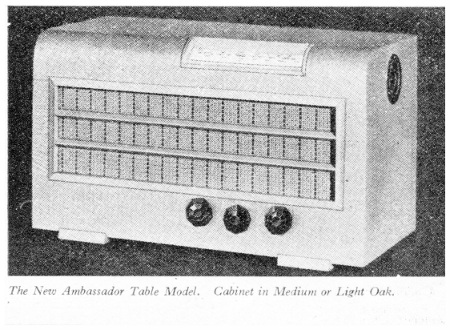 NINE REASONS WHICH PROVE Ambassador out values them all.
NINE REASONS WHICH PROVE Ambassador out values them all.
Six Valves (International Octal Base)
Six Wave Bands 10 to 565 metres continuously
Push Pull Output- 8 watts
Large Energised Speaker
Iron Cored H.F. Coils and I.F. Transformers
High L to C Ratios equivalent to the use of H.F. Amplification
Rotating Dial-- only One Band visible at a time
Operates on either A.C. or D.C. Mains
Costs only from GBP 14. 0. 0
Before you buy a new radio, examine, as thoroughly as you wish, this new Ambassador. For it is a set you cannot afford to overlook. It has the range and power to bring in all the worth while foreign stations; its energised speaker guarantees real pleasure in listening; the "works" are as sound as the preceding Ambassadors (that earned Ambassador the name for reliability); and its price is remarkably reasonable. This is the finest set of all time, and there's nothing to touch it. Please write for full details.
Ambassador
OUT VALUES THEM ALL
Write for details to the Manufacturers: R. N. FITTON LIMITED, BRIGHOUSE, YORKS ENGLAND.
Cable Export Enquiries to: Ambassador, Brighouse, England.
Contact me
Access Key Details
 Fettered to the fireside.
Fettered to the fireside. 

 R.I. Ritz Airflo
R.I. Ritz Airflo








 FEATURES
FEATURES


 What is it like on SHORT WAVES?
What is it like on SHORT WAVES?
 H.M.V. "All-dry" Portable
H.M.V. "All-dry" Portable

 June 1940 Advertisement
June 1940 Advertisement June 1940:
June 1940:
 Shortwave 16.7 to 51 metres; Mediumwave 197 to 580 metres; Longwave 708 to 2000 metres.
Shortwave 16.7 to 51 metres; Mediumwave 197 to 580 metres; Longwave 708 to 2000 metres.
 Test Report
Test Report
 NINE REASONS WHICH PROVE Ambassador out values them all.
NINE REASONS WHICH PROVE Ambassador out values them all.